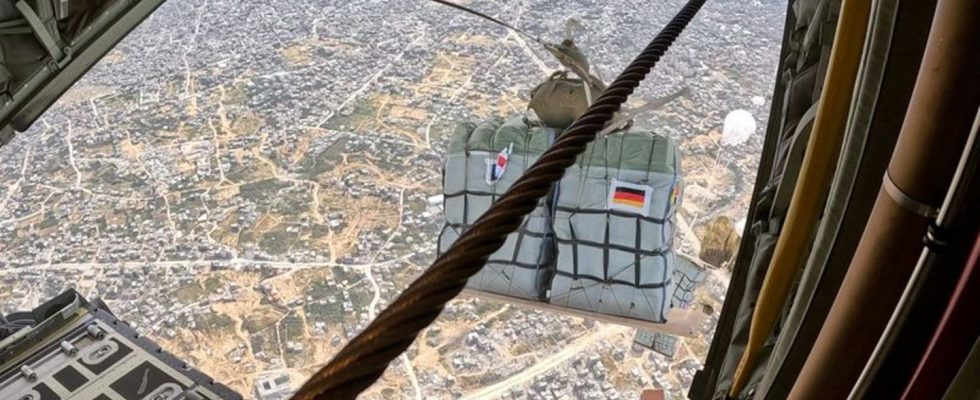War in the Middle East
Bundeswehr drops food for Gaza Strip
A C-130 from the Bi-National Squadron “Rhein” drops relief supplies over the Gaza Strip. photo
© Christian Timmig/Bundeswehr/dpa
People in the Gaza Strip live under catastrophic conditions. More aid supplies are arriving in the contested area via parachutes, but the supply route remains a “drop in the ocean.”
The air force has started dropping relief supplies for the suffering population in the embattled region Gaza Strip started. The first delivery of rice and flour, among other things, was parachuted from a C-130 Hercules transport aircraft over the north of the Palestinian territory on Saturday. The next delivery is scheduled for Sunday. “We delivered the four pallets precisely from a height of around 1,000 meters,” wrote the Air Force on Platform X. Four tons of food were dropped. Defense Minister Boris Pistorius gave the green light for the operation on Wednesday.
For this purpose, the Bundeswehr relocated two C-130 transport aircraft stationed in France to Jordan. The Arab country initiated the airlift. Other partners such as the USA are already taking part. Each of the German machines can transport up to 18 tons of load. “We are prepared to be available as long as there is a need for transport and drop-off,” a spokesman for the Ministry of Defense said on Friday.
For the Bundeswehr, dropping supplies by parachute from the C-130 is a “novelty,” as the Air Force writes. Preparations for the first mission in cooperation with France have been underway in Jordan since early Saturday morning. The Air Force cited “two challenges”: It is important that the load lands in the planned drop zone. Otherwise, the impacting packages could damage buildings or infrastructure. “Packages that end up in the sea or in inaccessible areas can pose a danger to those in need who try to reach them at the risk of their own harm. Therefore, suitable zones are identified in advance that are unpopulated and yet can be accessed safely,” said the Air Force.
At the same time, protection of the aircraft and its crew must be ensured. “Shelling from the ground cannot be ruled out in crisis areas,” it said. “Although reduced altitude and airspeed make landing easier, minimum values must be adhered to. In addition, the Hercules has its own protection systems.”
Residents: Desperate people fight each other for help
The people on the ground face completely different dangers. That is why there are divided views in the Gaza Strip about the effectiveness and usefulness of the airdrops. Some residents of the coastal strip say that they got some food this way, as an employee of the dpa news agency reported. Others complain that they haven’t gotten anything out of it so far. They walked long distances to see desperate people fighting over the loads at the places where the pallets landed.
A week ago, a pallet whose parachute failed to open killed five people during a drop. A young man criticized the fact that, in one case, airdrops fell in an active combat zone, with Israeli soldiers in close proximity. Residents and aid organizations agree that the airdrops are nothing more than a drop in the ocean. A plane load that is transported to its destination with great effort is roughly equivalent to the amount that a truck can transport. On Thursday, Israel said it let 244 trucks carrying aid supplies into the Gaza Strip, but only 33 of them reached the northern part of the coastal area, where the need is particularly great. Before the war, around 500 trucks with aid supplies came into the Gaza Strip every day.
Catastrophic situation
The situation of the civilian population in the sealed-off coastal strip is now catastrophic. There is a lack of everything – not just food, but also shelters, medical care and sanitary facilities. Aid organizations continue to report how desperate people are. In their view, the situation cannot be sufficiently improved through load shedding alone. According to the UN, there is a risk of a hunger crisis in the coastal strip if aid deliveries by truck are not increased. Around 2.2 million people live in the Gaza Strip.
The Gaza war was triggered by the worst massacre in Israel’s history, carried out by terrorists from the Islamist Hamas and other extremists on October 7th. On the Israeli side, more than 1,200 people were killed. Israel responded with massive air strikes and a ground offensive in the Gaza Strip. On the Palestinian side, more than 31,100 people have been killed since the war began, according to the Hamas-controlled health authority.
On Friday, the federal government reiterated its call on Israel to allow humanitarian aid for the population more quickly and on a larger scale. “Sea transport, air transport cannot replace land transport,” said a spokesman for the Foreign Office. He also spoke of a “drop in the ocean.” There is criticism of the Israeli military’s actions from many countries. And criticism is also becoming sharper in and towards Germany, before Chancellor Olaf Scholz (SPD) was expected in the Middle East region at the weekend.
“Israel’s legitimate self-defense has turned into a campaign of destruction. German politicians are turning a blind eye to this. This is wrong and dangerous,” wrote the “Spiegel” in an editorial on Saturday. And at the Berlin government press conference on Wednesday, the spokesman for the Foreign Office was asked whether it was a novelty in Germany’s foreign policy history “that one side is supplied with weapons and the other side with food.” He replied: “I would now reject the insinuation in your question.” Israel was the victim of a terrorist attack. “And it is Hamas that has brought this suffering to the Palestinian population with its attacks on Israel.”

